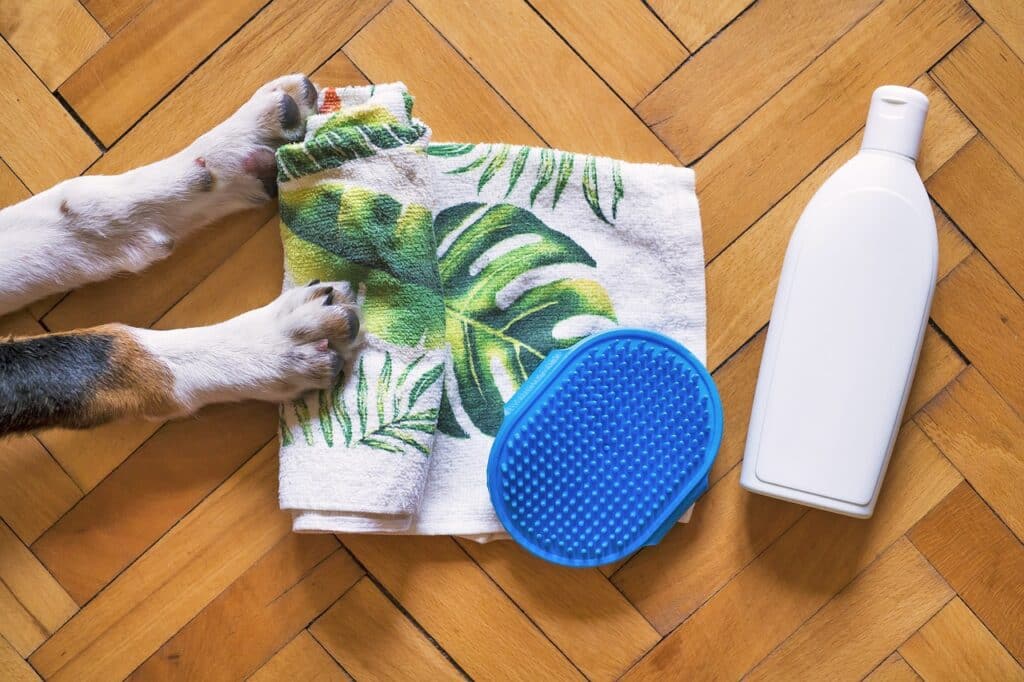Whether scratching a curious itch or just adding a furry friend to your home for the first time. We understand the anxieties that come with being a new, or even an existing dog parent, and trying to do right by your pal. Just remember, stay paw-sitive, you got this!
One commonly asked question is “how often do you bathe a dog?” By the end of this read, you’ll have all the answers to your burning questions, relating to factors that influence dog baths, and even how to best go about it. Let’s get into it.
How Often to Bathe a Dog
Washing is an important aspect of maintaining pet hygiene. But when it comes to dogs, very frequent baths can do more harm than good. This is because baths tend to strip off natural oils, and can result in unusual dryness and persistent itching when performed daily, or multiple times in a week.
You’ve likely noticed how furry animals tend to shed naturally. Shaking off excess fur and loose dirt. This natural self-cleaning mechanism helps keep them relatively fresh without a daily dose of encounters with soap and water. Grooming your dog through regular fur brushing will also help in a similar way.
Now, just because you give regular fur brushings, and your pooch likes to shake about or even shed around the house, this doesn’t mean that baths are completely off the table. Whatever your dog breed – at some point, you’re bound to notice a not-so-funny smell, and will ultimately need to give them a good cleaning.
Animal experts suggest once a month as being a good target. However, after hearing this, some pup parents may be concerned, thinking “Only once a month?!” “No one will ever want to visit me or my pooch again!” However, the best timing for your dog will ultimately depend on several factors, which we’ll be going over next.
Once a week might sound like a good choice at first thought. However, this could be on the extreme side for some dogs, and should only be done under special circumstances such as a vet recommendation.
Also, when it comes to newlyborn pups, it’s generally best to leave the cleaning job to their biological mom up until at least eight weeks of age. Below we’ve included some great, and important, factors to consider when it comes to bathing your dog. Read on for more on helpful things to consider when selecting a good cleaning regimen for your pup.
Factors to Consider
Environmental exposure – a farm dog or any dog that spends a majority of its time outdoors is likely to need more frequent baths than a stay-at-home pooch. Again, if your dog happens to be extra hyper and enjoys rolling around in the dirt, then you may require a couple more washroom visits when compared to a stay-at-home, or indoor dog.
Coat type – different dog breeds require different attention. For instance, pups with shorter hair can have spread-out bath times compared to those with longer fur. As you can imagine, dogs with longer fur tend to collect and hold onto dirt.
This will also be the case with oilier breeds. They tend to get stinkier much faster. So a shower every two weeks wouldn’t be a bad idea.
Dog health – dogs with skin allergies or flea infections are a special case. Your vet may instruct you on a personalized wash schedule, and this is okay. In these instances, we would always advise following your vet’s advice. After all, they’ll provide you with tailored instructions specific to your pup and their condition.
Just be sure to use dog-friendly shampoos. Your vet should recommend some good ones to you for special cases. But if in doubt, it never hurts to ask!
While on the topic, this would also be a great time to mention performing checks on your pal as part of the grooming process. You are going to be hands-on, after all. Once you two have a bath routine down, this would be a good time to take a quick mental note of any unusual-looking or feeling spots on their skin that you might notice. This way you can go back and check later.
The idea and expectation here is that you won’t find anything. But, it never hurts to check! Another good time would be in the fur drying process (for some dogs) and while brushing your pet’s fur. Basically, anytime you’re up close and personal with your fur baby.
Personal health – perhaps you’re sensitive to outdoor allergens, pet fur or dander, or have someone at home who is. Apart from an at home air purifier, regular baths may also make the environment more tolerable. The important thing here is to work closely with your vet in case you’re unsure of what might work best for both you and your dog.
Finally, when bathing your pet, it’s a good idea to use warm water and dog-specific shampoos and conditioners, which can help with retaining moisture and leaving a nice, soft, and fluffy coat.
Bonus Tips
Getting your dog to sit easy during their doggy wash may be hard at first, but with a bit of treat motivation and praise, it should get easier. Treat motivation simply involves instructing your dog on the action you’d like for them to take, along with a command that you expect to use going forward.
Each time they follow the command, you give them praise and/or a treat as positive reinforcement. This will show them just how much you appreciate their following your command. In time, they should be more cooperative. All thanks to direction, praise, and positive reinforcement through treat motivation!
Once the deed is done, following up with a soft towel is a great option for the drying process, followed up by a soothing dog-friendly lotion, which can also be used to help restore lost moisture.
So, how often should you bathe a dog? Ultimately, bath frequency will be dependent on various factors, as outlined above. Generally, once a month is perfect for some dogs, while oily breeds and more active – outside dogs, would do great with a more frequent bathing cycle of twice a month, or once every other week. We’d recommend leaving more frequent washing schedules to a vet recommendation, and in special circumstances that warrant such frequency.


